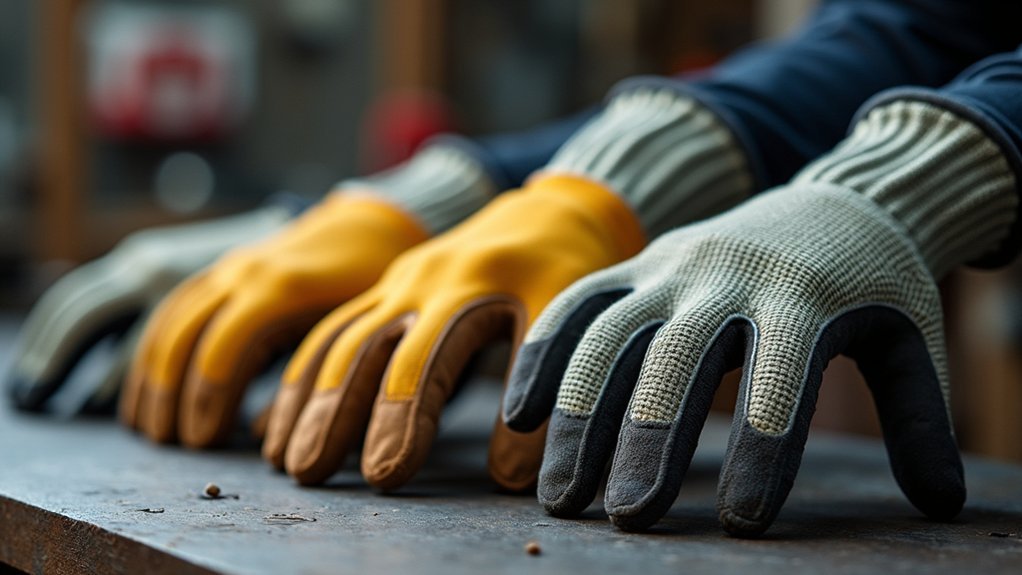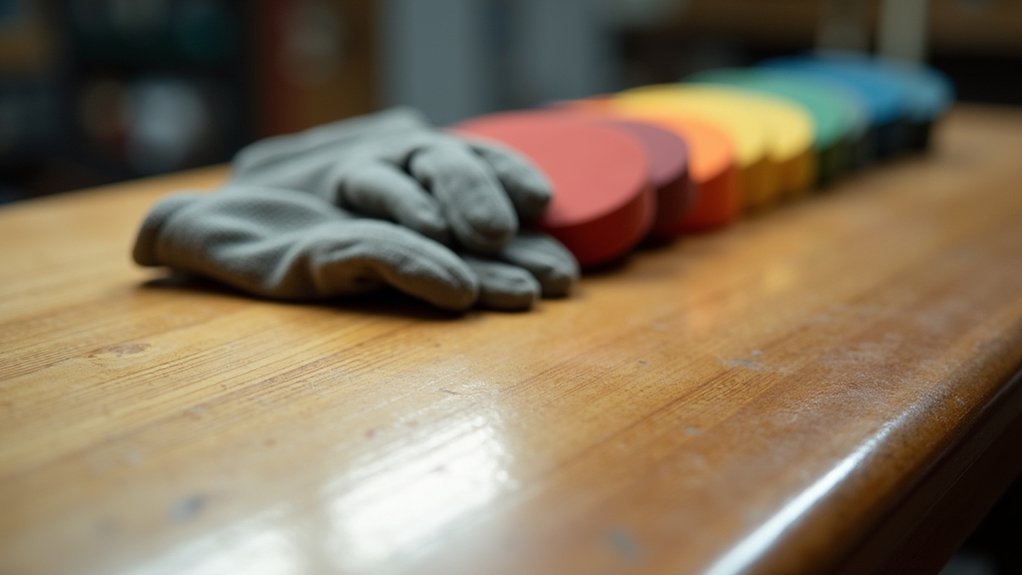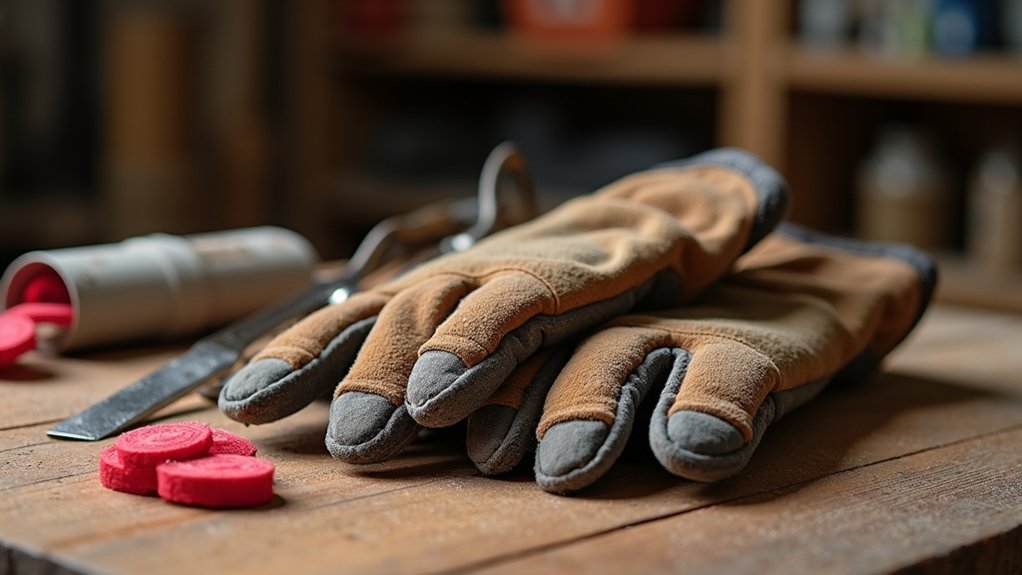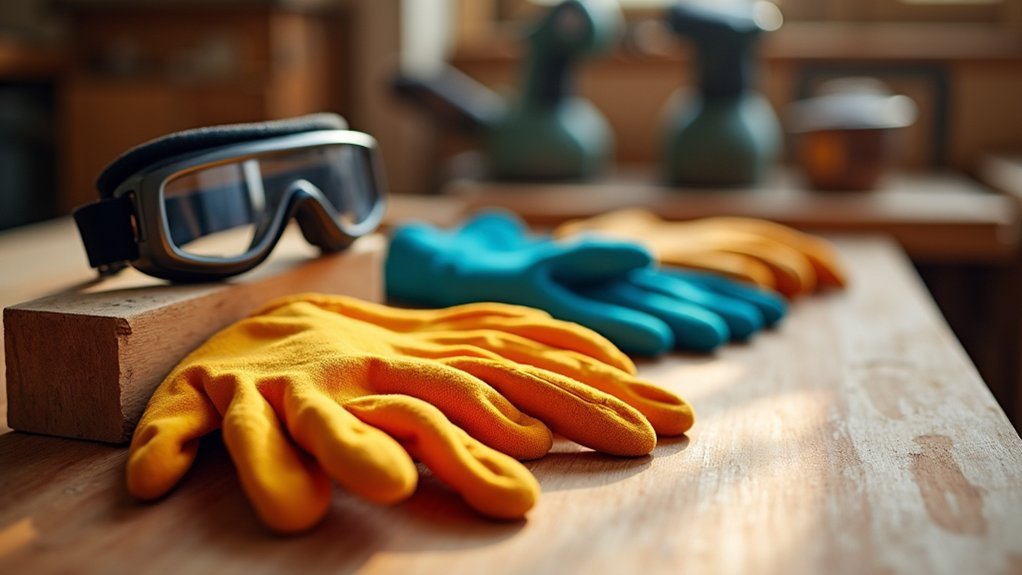You’ll protect your hands during finishing work by wearing cut-resistant gloves and safety goggles to prevent lacerations from sharp tools. Use chemical-resistant gloves when handling polishing compounds, and rinse any skin exposure with running water for 20 minutes. Take breaks every 30-45 minutes to prevent repetitive strain injuries, keep your workspace organized to avoid tool slips, and maintain accessible first aid supplies. Understanding these fundamentals opens the door to mastering thorough hand safety protocols.
Understanding Common Hand Injuries in Jewelry Finishing

While jewelry finishing creates beautiful pieces, it also presents significant risks to your hands that you must understand to stay safe.
The most common hand injuries you’ll face include lacerations from sharp tools, crush injuries from heavy machinery, and painful burns from abrasive materials or chemicals.
You’re also at risk for cumulative trauma disorders from repetitive polishing motions that can reduce your hand strength over time.
Working with small, intricate tools increases your chances of finger injuries when tools slip or you lose control.
Hot surfaces and flying debris pose additional threats that can cause severe damage.
Understanding these risks helps you take proper precautions, including wearing appropriate Personal Protective Equipment (PPE) like cut-resistant safety gloves and protective eyewear.
Essential Personal Protective Equipment for Polishing Work
Before you begin any polishing work, you must equip yourself with the right personal protective equipment to shield your hands and body from serious injury.
Cut-resistant gloves provide essential hand protection against lacerations from sharp edges and tools. Safety goggles shield your eyes from flying debris, while dust masks prevent inhalation of harmful particles that can damage your respiratory system.
Essential protective gear including cut-resistant gloves, safety goggles, and dust masks prevents serious injuries from sharp tools and airborne debris.
Don’t overlook knee pads when working on lower surfaces—they’ll protect your joints from strain and injury.
Proper personal protective equipment (PPE) only works when it’s correctly fitted and well-maintained. Check your gear regularly for wear and replace damaged items immediately.
Consider investing in safety training to learn proper PPE usage techniques and identify potential hazards before they cause harm.
Proper Glove Selection for Chemical and Abrasive Protection

When you’re selecting gloves for finishing work, you’ll need to evaluate chemical resistance ratings to verify they can withstand the specific solvents and compounds you’re using.
Check the abrasion protection levels to assure your gloves won’t deteriorate when handling rough materials or tools.
Most importantly, follow proper fit guidelines since loose or tight gloves can compromise both your safety and work quality.
Chemical Resistance Ratings
The foundation of effective hand protection lies in understanding chemical resistance ratings before selecting gloves for finishing work. These ratings indicate how well your personal protective equipment (PPE) withstands specific chemicals you’ll encounter during projects.
Manufacturers test gloves using standardized methods to determine permeation and degradation rates, providing essential data for proper selection.
You’ll find that different materials like nitrile, latex, and PVC offer varying protection levels against specific substances. Always check manufacturer specifications to match chemical resistance ratings with your project requirements.
This careful selection process will protect your hands while reducing skin irritation and long-term health risks from chemical exposure.
Remember to regularly inspect your gloves for wear and damage, as even chemically-rated gloves can become compromised over time.
Abrasion Protection Levels
Beyond chemical threats, your gloves must withstand the physical demands of abrasive materials and rough surfaces common in finishing work. Understanding abrasion protection levels helps you select the right gloves for your specific tasks.
The EN 388 standard categorizes gloves based on their resistance to wear and tear, with ratings ranging up to Level 4 or Level 5 indicating superior durability.
Higher abrasion protection levels offer better resistance when you’re handling rough surfaces, sandpaper, or metal components.
Don’t compromise on protection – gloves with inadequate abrasion resistance will fail quickly, leaving your hands vulnerable to cuts and scrapes.
Proper injury prevention training should emphasize selecting gloves with appropriate protection levels for each finishing application, ensuring both immediate safety and long-term hand health.
Proper Fit Guidelines
Ideal glove fit serves as your first line of defense against workplace injuries and chemical exposure. Following proper fit guidelines guarantees you’re maximizing employee safety during finishing operations.
You’ll need gloves that fit snugly without restricting blood circulation – tight gloves reduce dexterity and cause fatigue, while loose ones create dangerous snag hazards around machinery.
Select gloves designed specifically for your chemicals and abrasives, as different materials offer varying protection levels. Choose options with textured coatings for enhanced grip on tools and slippery surfaces.
You should regularly check your glove fit throughout shifts since temperature changes and hand swelling affect comfort and effectiveness.
Always consult safety data sheets before selecting glove materials to guarantee adequate protection against chemical skin exposure.
Safe Handling of Polishing Compounds and Solutions

Why risk chemical burns or respiratory problems when simple precautions can keep you safe while handling polishing compounds? Your safety depends on wearing proper Personal Protective Equipment (PPE), including chemical-resistant gloves and goggles, to prevent hand injury and eye irritation.
You’ll need adequate ventilation to avoid inhaling harmful fumes that can cause respiratory issues.
Always read Safety Data Sheets for each compound you’re using to understand specific hazards and emergency procedures.
Store your polishing compounds in clearly labeled, sealed containers to prevent accidental contact and maintain workspace organization.
When you’re finished, dispose of compounds and containers according to local regulations to protect the environment and maintain workplace safety standards.
Maintaining Clean and Organized Workstation Areas
You’ll protect your hands best by keeping your workspace spotless and systematically arranged throughout each finishing project.
Clear away debris immediately as it accumulates, organize your tools in designated spots where you can grab them safely, and prevent clutter from building up around your work area.
These simple habits create a safer environment where you’re less likely to suffer cuts, punctures, or other hand injuries from unexpected contact with sharp materials or misplaced equipment.
Clear Debris Immediately
One of the most effective ways to protect your hands during finishing work is maintaining a debris-free workspace at all times. When you clear debris immediately, you’ll eliminate sharp materials and splinters that pose serious risks to your hands.
These hazards often hide in cluttered areas where you’re reaching for tools or materials, making hand injuries more likely to occur.
Don’t wait until the end of your shift to clean up. Remove construction waste, wood shavings, and sharp objects as soon as they accumulate. This practice enhances workstation safety by keeping pathways accessible and reducing tripping hazards that can cause falls and subsequent hand injuries.
Establish a routine where you dispose of debris throughout the day, not just during scheduled cleanup times.
Organize Tools Properly
When tools scatter across your workstation, you’re setting yourself up for preventable hand injuries that can sideline your finishing work for weeks. To organize tools properly and maintain hand safety, implement a designated storage system that keeps sharp instruments and heavy materials in secure locations.
| Storage Zone | Tool Type | Safety Benefit | PPE Reminder | Maintenance Check |
|---|---|---|---|---|
| Upper rack | Hand sanders | Prevents drops | Wear gloves | Weekly inspection |
| Lower drawer | Sharp blades | Reduces cuts | Cut-resistant sleeves | Daily check |
| Wall mount | Heavy hammers | Eliminates crush risk | Safety glasses | Monthly review |
| Tool belt | Small items | Easy access | Proper grip gloves | Before each use |
| Locked cabinet | Power tools | Controlled access | Full personal protective equipment (PPE) | Per manufacturer |
Proper organization increases productivity by 20% while preventing defective equipment injuries.
Prevent Clutter Buildup
Storage systems work best when you maintain them consistently. To prevent clutter buildup effectively, you’ll need to establish daily routines that keep your organized workstation functioning properly.
Wood shavings, leftover materials, and misplaced tools create dangerous conditions that can lead to lacerations and puncture wounds.
Implement these essential practices:
- Clear debris immediately after each task completion
- Return tools to designated storage locations before starting new projects
- Remove sharp objects from work surfaces at day’s end
- Sweep pathways to eliminate tripping hazards
These habits enhance visibility around your workspace, helping you identify potential dangers before they cause accidents.
Daily cleanup tasks also build a strong safety culture where everyone takes responsibility for protecting their hands and maintaining secure work environments.
Correct Tool Usage and Regular Equipment Inspection
Although finishing work demands precision and attention to detail, your safety depends entirely on using the right tools correctly and keeping them in peak condition.
Correct tool usage starts with following manufacturer guidelines and using each tool as intended. Don’t improvise or take shortcuts that compromise safety protocols.
Regular equipment inspection prevents most accidents before they happen. Check for dull blades, loose parts, or damaged components before starting any task.
Familiarize yourself with safety features like emergency shut-off switches on every tool you operate.
Many injuries can be prevented through proper maintenance and storage practices. Service your tools regularly to avoid malfunctions, and store them securely when not in use to prevent accidental activation or contact with moving parts.
Managing Ergonomic Risks During Extended Finishing Sessions

Extended finishing sessions put your hands and wrists at serious risk for repetitive strain injuries that develop gradually through cumulative stress.
These ergonomic risks stem from awkward hand positions and repetitive motions that strain your muscles and joints over time.
To prevent hand injuries during lengthy finishing work, implement these protective strategies:
- Take regular breaks every 30-45 minutes to stretch your hands, wrists, and forearms.
- Use ergonomic tools with comfortable grips that reduce strain on your joints.
- Adjust your workstation height to maintain neutral wrist positioning throughout tasks.
- Wear appropriate personal protective equipment (PPE) that supports proper hand alignment.
You’ll markedly reduce your injury risk by modifying work processes that force uncomfortable postures and incorporating stretching exercises into your routine.
Jewelry and Loose Clothing Removal Guidelines
Before you begin any finishing work, remove all jewelry and secure loose clothing to eliminate serious safety hazards. Rings, bracelets, and necklaces can snag on equipment, causing severe hand injuries or amputations.
You’ll want to store these items safely away from your work area.
Loose clothing poses equally dangerous risks. Baggy sleeves, untucked shirts, or flowing garments can catch on moving machinery, pulling you into hazardous situations.
Always wear fitted clothing that won’t interfere with your movements or equipment operation.
Consider wearing fitted gloves to enhance your grip and control during finishing tasks. Remove any dangling accessories like lanyards or loose belts.
These simple safety precautions greatly reduce your risk of preventable injuries while maintaining ideal dexterity for precise finishing work.
Emergency Response Procedures for Hand Injuries

Within seconds of a hand injury occurring, you’ll need to quickly assess the severity to determine your next steps. Severe lacerations or amputations require immediate emergency response procedures and professional medical attention.
Keep these essential emergency response procedures ready for hand injuries:
- Control bleeding – Apply direct pressure using clean cloth or bandage while awaiting help.
- Chemical exposure treatment – Rinse affected area with running water for 20 minutes minimum.
- Maintain first aid supplies – Keep dressings, antiseptics, and gloves easily accessible.
- Know emergency contacts – Have medical facility locations and reporting procedures readily available.
For chemical burns or serious wounds, seek medical assistance immediately.
Train all workers on proper emergency response procedures, including injury reporting protocols and nearest medical facility locations to guarantee swift, effective treatment when hand injuries occur.
Temperature and Chemical Burn Prevention Strategies
You’ll face two major burn risks during finishing work: direct contact with heated materials and exposure to caustic chemicals.
Heat-resistant gloves protect your hands from hot surfaces and tools, while chemical-resistant gloves shield you from acids, solvents, and other hazardous substances.
Understanding these heat sources and chemical dangers helps you select the right protective equipment for each specific finishing task.
Chemical Exposure Protection
Chemical exposure poses one of the most serious threats to your hands during finishing work, as many common materials contain corrosive substances that can cause severe burns and long-term health problems.
Proper chemical exposure protection requires selecting appropriate personal protective equipment (PPE) and following established safety protocols.
Essential protection measures include:
- Choose chemical-resistant gloves that fit properly and match the specific substances you’re handling.
- Consult Safety Data Sheets (SDS) before working with any chemical to understand required PPE and safety precautions.
- Implement engineering controls like proper ventilation to minimize inhalation of volatile organic compounds and chemical fumes.
- Label and store containers properly to prevent accidental exposure and maintain an organized, hazard-free workspace.
These strategies greatly reduce your risk of chemical burns and long-term health complications.
Heat Sources Awareness
Heat sources present dual dangers during finishing work—both from direct thermal contact and from chemical reactions that generate unexpected temperatures.
You’ll encounter obvious heat sources like heating guns and sanders, but don’t overlook metals that retain heat long after you’ve turned equipment off. Always test surface temperatures before handling tools or materials.
Wear heat-resistant gloves as part of your personal protective equipment (PPE) when working near any heat sources. Some finishing products generate heat during application or curing, creating unexpected burns.
Check Safety Data Sheets to understand chemical properties and potential thermal reactions.
Store all chemicals away from direct heat sources to prevent dangerous reactions.
Proper ventilation helps dissipate heat buildup while protecting you from harmful chemical exposure that can cause skin burns.
Safe Storage and Disposal of Finishing Materials
While proper technique protects your hands during application, storing and disposing of finishing materials safely guarantees long-term protection for you and the environment.
Creating a safe work environment extends beyond wearing personal protective equipment (PPE) during active work—it requires consistent vigilance in material management to prevent accidents and injuries.
Follow these essential storage and disposal practices:
- Label and seal containers tightly to prevent leaks and chemical exposure that could harm your hands during handling.
- Use designated storage areas that are cool, dry, and well-ventilated to minimize fire risks and material degradation.
- Keep materials away from heat sources and direct sunlight to prevent dangerous reactions.
- Inspect storage areas regularly for leaks or spills, addressing issues immediately to maintain workplace safety.
Creating Daily Safety Habits and Awareness Practices
Although proper storage and disposal form the foundation of workshop safety, developing consistent daily habits guarantees your hands stay protected throughout every finishing project.
Start each workday by inspecting your safety equipment and personal protective equipment (PPE) to verify everything’s functioning properly. Check hand tools for damage that could cause slips or cuts during detailed work.
Take regular breaks to combat fatigue—tired workers make careless mistakes that endanger their hands.
Create a daily checklist that reminds you to select proper gloves for each task, maintaining both dexterity and protection.
Review safety data sheets for chemicals you’ll use, understanding proper handling procedures.
Report near misses immediately to supervisors, fostering workplace safety awareness that prevents future incidents.
Regular Safety Training and Hazard Communication Updates
Beyond establishing personal safety routines, your workshop needs structured training programs that keep everyone current on proper hand protection techniques.
Regular safety training guarantees you’ll stay informed about evolving hazards and new materials entering your workspace.
Staying current through regular safety training ensures you recognize new workplace hazards and material risks before they endanger your hands.
Effective training programs should include:
- Hands-on demonstrations of safe finishing techniques so you can practice proper methods before working independently
- Annual hazard communication updates covering new chemicals and their required personal protective equipment (PPE)
- Updated Safety Data Sheets access during sessions to understand specific material risks and handling procedures
- Worker feedback integration to improve Job Safety Analysis and address real workplace concerns
Your supervisors should participate alongside you in these sessions, reinforcing that safety isn’t optional but essential for protecting your hands during finishing work.
Frequently Asked Questions
What Does OSHA Say About Hand Safety?
OSHA requires you to conduct hazard assessments, wear appropriate PPE like gloves, receive proper training on tool use, access Safety Data Sheets for chemicals, and report hazards to prevent hand injuries.
How Would You Ensure the Safety of the Hands of the Workers?
You’d conduct hazard assessments, provide cut-resistant gloves and proper PPE, install machine guards, train workers on safe tool usage, maintain equipment regularly, and encourage immediate reporting of near-misses to continuously improve safety protocols.
Why Is It Important to Keep Your Hands Safe While Working?
You’ll protect your livelihood and career by keeping hands safe. Hand injuries can sideline you for months, affecting your income and ability to work effectively in any field requiring manual dexterity.
How Do You Keep Your Hands Safe?
You’ll keep your hands safe by wearing properly-fitted cut-resistant gloves, regularly inspecting tools for defects, staying focused while working, taking breaks to avoid fatigue, and using proper handling techniques for materials.
In Summary
You’ve got the knowledge to protect your hands during finishing work—now it’s time to put it into practice. Don’t let familiarity breed complacency; even experienced jewelers can suffer preventable injuries. Make safety gear non-negotiable, keep your workspace organized, and stay current with training. Your hands are your livelihood in this craft, so treat them with the respect they deserve. Consistent safety habits today prevent costly injuries tomorrow.





Leave a Reply